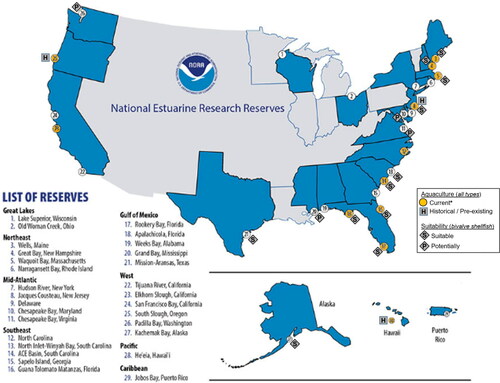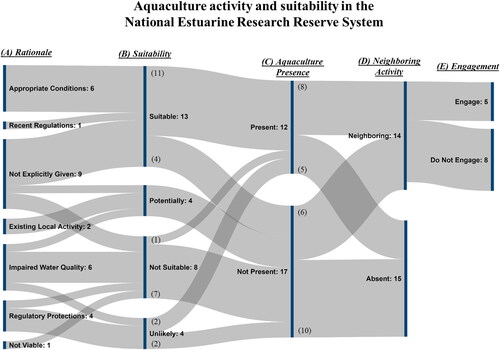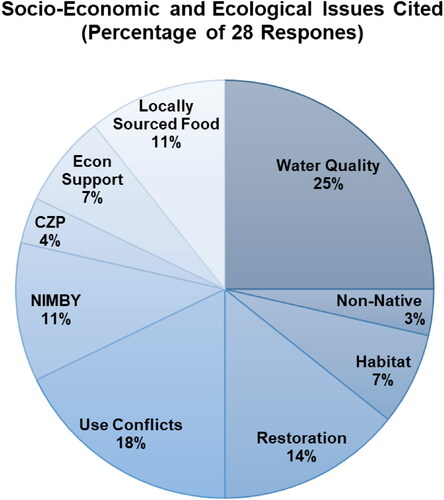Figures & data
Table 1. National Estuarine Research Reserves.
Figure 1. Aquaculture activities (of all types) and suitability for bivalve shellfish aquaculture across the National Estuarine Research Reserve (NERR) System. Orange circles indicate the current* presence of aquaculture within Reserve boundaries, as of the information collection (*May 2020). Reserves with aquaculture activities as a historical or preexisting use are demarcated with a boxed “H”. Suitability is indicated by diamonds, with the letter “S” indicating “Suitable” conditions, and “P” indicating “Potentially” suitable conditions. Note that three Reserves have current aquaculture activities, but without “Suitable” designations. This is due to the either: the discontinuation of existing shellfish leases and establishment of leasing moratoriums within several NC counties, despite current permitted activities (North Carolina NERR); the Reserve is a state-designated marine protected area, although select preexisting aquaculture activities were allowed to remain upon Reserve designation (South Slough NERR); the Reserve is a state-designated marine protected area with impaired water quality conditions, and thus the application of aquaculture is specifically for conservation purposes (Elkhorn Slough NERR).

Table 2. Shellfish aquaculture activities within or neighboring to each of the National Estuarine Research Reserves.
Figure 2. Sankey plot of aquaculture activities and their presence in Reserves. Each column synthesizes survey responses (see ). For the presence of aquaculture within the Reserve (Colum C) and whether or not aquaculture is currently suitable within a reserve (Column B). The primary reason for suitability, or lack there-of, is provided in Column A. Questionnaire phrasing and responses, did not allow “Suitability” to be discerned by the type (e.g., bivalve shellfish vs. shellfish) or purpose of aquaculture (e.g., commercial vs. restorative). Thus, in the context and scope of this study, we considered “Suitability” would primarily apply to commercial activities. Neighboring aquaculture activities, which were considered to have a shared hydrologic connection with the Reserve, and Reserve engagement is synthesized in Column D and E, respectively. Note that the potential for category alignment at each node does not reference the same Reserve. For example the “Recent Regulations” category does not necessitate that aquaculture is “Suitable” or “Present” despite the seemingly uninterrupted flow between nodes.

Figure 3. (A) Percentage of socio-economic and ecological topics that were able to be categorized from survey responses and personal correspondence (see Methodology) in relation to aquaculture activities within or neighboring to the Reserve. There is no discrimination between positive or negative connotations within each topic. CZP: Coastal Zone Protection; Econ Support: Economic Support; Non-Native: Non-Native Species; NIMBY: Not In My Backyard.

